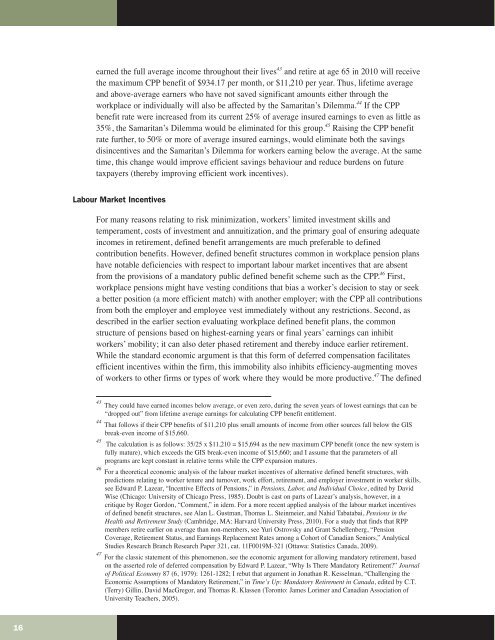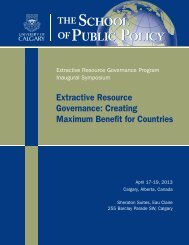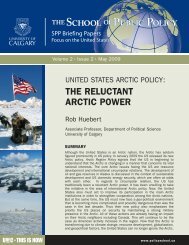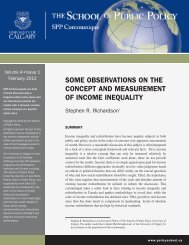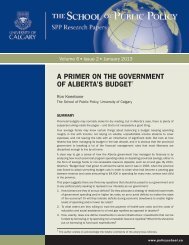EXPANDING CANADA PENSION PLAN RETIREMENT BENEFITS Assessing Big CPP Proposals
EXPANDING CANADA PENSION PLAN RETIREMENT BENEFITS ...
EXPANDING CANADA PENSION PLAN RETIREMENT BENEFITS ...
You also want an ePaper? Increase the reach of your titles
YUMPU automatically turns print PDFs into web optimized ePapers that Google loves.
earned the full average income throughout their lives 43 and retire at age 65 in 2010 will receivethe maximum <strong>CPP</strong> benefit of $934.17 per month, or $11,210 per year. Thus, lifetime averageand above-average earners who have not saved significant amounts either through theworkplace or individually will also be affected by the Samaritan’s Dilemma. 44 If the <strong>CPP</strong>benefit rate were increased from its current 25% of average insured earnings to even as little as35%, the Samaritan’s Dilemma would be eliminated for this group. 45 Raising the <strong>CPP</strong> benefitrate further, to 50% or more of average insured earnings, would eliminate both the savingsdisincentives and the Samaritan’s Dilemma for workers earning below the average. At the sametime, this change would improve efficient savings behaviour and reduce burdens on futuretaxpayers (thereby improving efficient work incentives).Labour Market IncentivesFor many reasons relating to risk minimization, workers’ limited investment skills andtemperament, costs of investment and annuitization, and the primary goal of ensuring adequateincomes in retirement, defined benefit arrangements are much preferable to definedcontribution benefits. However, defined benefit structures common in workplace pension planshave notable deficiencies with respect to important labour market incentives that are absentfrom the provisions of a mandatory public defined benefit scheme such as the <strong>CPP</strong>. 46 First,workplace pensions might have vesting conditions that bias a worker’s decision to stay or seeka better position (a more efficient match) with another employer; with the <strong>CPP</strong> all contributionsfrom both the employer and employee vest immediately without any restrictions. Second, asdescribed in the earlier section evaluating workplace defined benefit plans, the commonstructure of pensions based on highest-earning years or final years’ earnings can inhibitworkers’ mobility; it can also deter phased retirement and thereby induce earlier retirement.While the standard economic argument is that this form of deferred compensation facilitatesefficient incentives within the firm, this immobility also inhibits efficiency-augmenting movesof workers to other firms or types of work where they would be more productive. 47 The defined43 They could have earned incomes below average, or even zero, during the seven years of lowest earnings that can be“dropped out” from lifetime average earnings for calculating <strong>CPP</strong> benefit entitlement.44 That follows if their <strong>CPP</strong> benefits of $11,210 plus small amounts of income from other sources fall below the GISbreak-even income of $15,660.45 The calculation is as follows: 35/25 x $11,210 = $15,694 as the new maximum <strong>CPP</strong> benefit (once the new system isfully mature), which exceeds the GIS break-even income of $15,660; and I assume that the parameters of allprograms are kept constant in relative terms while the <strong>CPP</strong> expansion matures.46 For a theoretical economic analysis of the labour market incentives of alternative defined benefit structures, withpredictions relating to worker tenure and turnover, work effort, retirement, and employer investment in worker skills,see Edward P. Lazear, “Incentive Effects of Pensions,” in Pensions, Labor, and Individual Choice, edited by DavidWise (Chicago: University of Chicago Press, 1985). Doubt is cast on parts of Lazear’s analysis, however, in acritique by Roger Gordon, “Comment,” in idem. For a more recent applied analysis of the labour market incentivesof defined benefit structures, see Alan L. Gustman, Thomas L. Steinmeier, and Nahid Tabatabai, Pensions in theHealth and Retirement Study (Cambridge, MA: Harvard University Press, 2010). For a study that finds that RPPmembers retire earlier on average than non-members, see Yuri Ostrovsky and Grant Schellenberg, “PensionCoverage, Retirement Status, and Earnings Replacement Rates among a Cohort of Canadian Seniors,” AnalyticalStudies Research Branch Research Paper 321, cat. 11F0019M-321 (Ottawa: Statistics Canada, 2009).47 For the classic statement of this phenomenon, see the economic argument for allowing mandatory retirement, basedon the asserted role of deferred compensation by Edward P. Lazear, “Why Is There Mandatory Retirement?” Journalof Political Economy 87 (6, 1979): 1261-1282; I rebut that argument in Jonathan R. Kesselman, “Challenging theEconomic Assumptions of Mandatory Retirement,” in Time’s Up: Mandatory Retirement in Canada, edited by C.T.(Terry) Gillin, David MacGregor, and Thomas R. Klassen (Toronto: James Lorimer and Canadian Association ofUniversity Teachers, 2005).16


